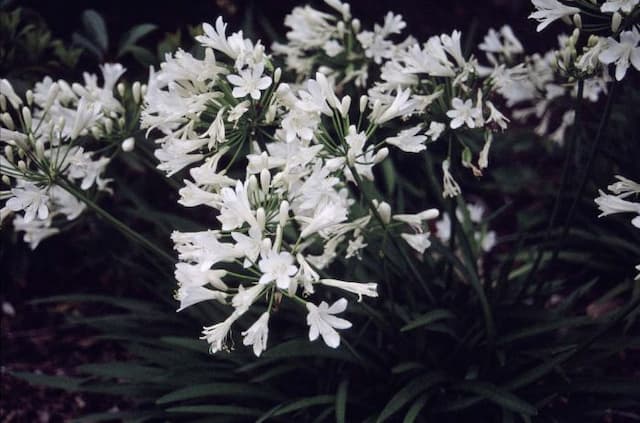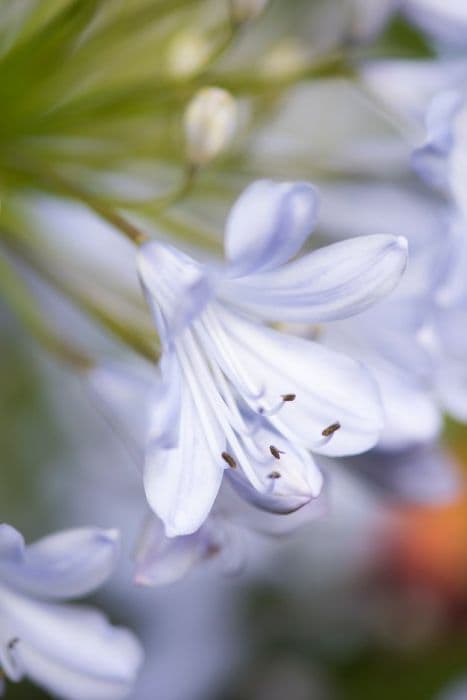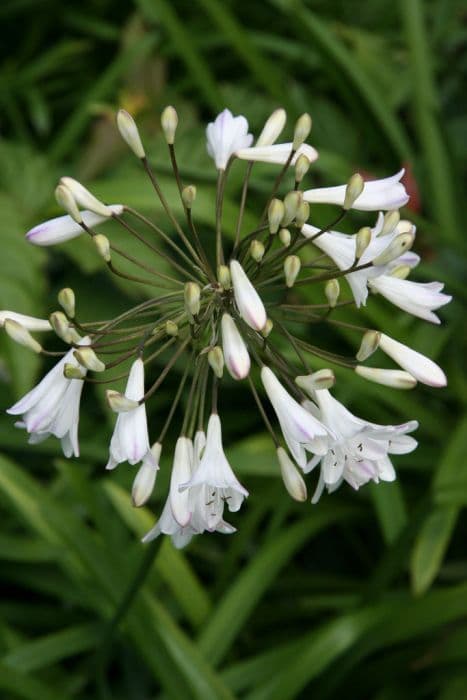African Lily Agapanthus africanus (L.) Hoffmanns.

ABOUT
Agapanthus africanus, commonly known as the African Lily, is a striking perennial plant that features a clump-forming growth habit. Its glossy, strap-like leaves arch gracefully and paint a lush green backdrop for the spectacular flowers. The leaves emanate directly from the base in a dense tuft, creating an attractive, verdant mound through much of the year. The most captivating feature of the African Lily is its flowers, which bloom at the top of long, slender stalks that rise above the foliage. Each stalk, or stem, culminates in a rounded cluster composed of numerous funnel-shaped flowers. The individual flowers are typically a deep blue or purple hue, although some variations with white or pale blue blooms exist. These flower clusters are quite large and globe-shaped, resembling an explosion of color at the tip of each stem. The elegant blossoms of the African Lily make it an excellent choice for ornamental gardens, border plantings, or as a focal point in landscape design. Their striking appearance is also popular in cut flower arrangements, where the tall flower stalks can add height and visual interest. The blooming period of the plant usually occurs during the warmer months, bringing a dynamic splash of color to the garden when many other plants are at their peak performance.
About this plant
 Names
NamesSynonyms
African Lily, Blue African Lily, African Blue Lily, Love Flower, Lily of the Nile.
Common names
Agapanthus umbellatus L'Hér., Crinum africanum (L.) Noronha, Mauhlia africana (L.) Dahl, Tulbaghia africana (L.) Kuntze.
 Toxicity
ToxicityTo humans
African Lily, the common name for Agapanthus africanus, contains toxic substances which can cause mild to moderate symptoms if ingested. These symptoms include nausea, vomiting, abdominal pain, and in rare cases, more severe reactions such as tremors or cardiac arrhythmia may occur. It's advised to avoid consumption of any part of the African Lily to prevent possible negative health consequences.
To pets
African Lily can be toxic to pets such as cats and dogs if ingested. The symptoms of poisoning in pets can be similar to those in humans and may include vomiting, diarrhea, abdominal pain, and lethargy. In severe cases, ingestion can lead to more serious symptoms, so it is important to keep the African Lily out of reach of pets and seek veterinary care if there is a suspicion of ingestion.
 Characteristics
CharacteristicsLife cycle
Perennials
Foliage type
Evergreen
Color of leaves
Green
Flower color
Blue
Height
2-3 feet (0.6-0.9 meters)
Spread
1-2 feet (0.3-0.6 meters)
Plant type
Herb
Hardiness zones
8
Native area
South Africa
Benefits
 General Benefits
General Benefits- Aesthetic Appeal: Agapanthus africanus, commonly known as African Lily, adds beauty to gardens with its tall stalks and stunning blue or white flower clusters.
- Easy to Grow: This plant is quite hardy and requires minimal care, making it suitable for novice gardeners or those with limited time.
- Drought Tolerance: African Lily is known for its ability to survive in drought-like conditions, making it a good choice for water-conserving landscapes.
- Attracts Pollinators: The blooms of Agapanthus attract bees, butterflies, and other beneficial pollinators, which are important for the health of the garden.
- Border and Pathway Edging: With its clumping habit and ornamental flowers, the African Lily serves as an excellent border or edging for garden pathways.
- Pest Resistance: Agapanthus africanus is fairly resistant to pests, which can reduce the need for chemical treatments in the garden.
- Cutting Flower: The long-lasting blooms make excellent cut flowers for arrangements, maintaining their form and color for extended periods.
- Erosion Control: The root system of Agapanthus helps to hold the soil in place, which can be beneficial on slopes or in areas prone to erosion.
- Variety of Uses: The African Lily suits various landscape designs, from contemporary to cottage gardens, offering flexibility in garden planning.
- Seaside Tolerance: It can withstand coastal conditions, such as salt spray and sandy soils, making it ideal for seaside gardens.
 Medical Properties
Medical PropertiesThis plant is not used for medical purposes.
 Air-purifying Qualities
Air-purifying QualitiesThis plant is not specifically known for air purifying qualities.
 Other Uses
Other Uses- Agapanthus africanus, commonly known as African lily, are used in bouquets and floral arrangements due to their striking blue or white flowers and long-lasting nature.
- The long, sturdy stalks of the African lily can be used in crafting, such as in the creation of plant-based pens or small handcrafted items.
- The sap from African lily has been historically used as an ingredient in traditional glues or adhesives.
- The fibrous leaves of the African lily can be woven into natural textiles or cords for various artisan uses, like making baskets or eco-friendly products.
- Gardeners utilize the African lily for its ability to help prevent soil erosion due to the plant's dense root system.
- These plants are also used as a natural pest deterrent in gardens, as some pests do not favor their taste or texture.
- African lily can be planted to create a natural privacy screen or windbreak in gardens due to its dense foliage and height when matured.
- The leaves of the African lily have been used to add greenery to food platters or as a natural decorative element on catering tables.
- Some cultures use dried African lily flowers in their ceremonies or as part of ornamental decorations in various festivals or events.
- Photographers and artists often feature the African lily in their work for its photogenic qualities and as a symbol of beauty and tranquility.
Interesting Facts
 Feng Shui
Feng ShuiThe African Lily is not used in Feng Shui practice.
 Zodiac Sign Compitability
Zodiac Sign CompitabilityThe African Lily is not used in astrology practice.
 Plant Symbolism
Plant Symbolism- Love: Derived from the Greek words 'agape' meaning love, and 'anthos' meaning flower, Agapanthus africanus, commonly known as the African lily, symbolizes love and affection.
- Beauty: The beautiful and striking blue to violet flowers of the African lily are often associated with beauty and elegance.
- Purity: The lush, trumpet-shaped flowers rising above the foliage convey a sense of purity and innocence.
- Prosperity: With its robust growth and large clumps of flowers, the African lily can symbolize prosperity and abundance.
 Water
WaterAfrican Lily, commonly known as Agapanthus africanus, benefits from thorough watering every week during the growing season, ensuring that the soil is kept consistently moist but not waterlogged. In the summer, you may need to water as much as 1 gallon per plant if the weather is particularly dry or hot. During its dormant period in the winter, reduce watering to every few weeks, just enough to prevent the soil from completely drying out. Overwatering can lead to root rot, so ensure proper drainage in the pot or the garden bed.
 Light
LightAfrican Lily thrives in full sun to partial shade. For optimal growth, place it in a spot where it can receive at least six hours of sunlight per day. However, if you live in an area with extremely hot summers, provide some afternoon shade to prevent the leaves from scorching.
 Temperature
TemperatureAfrican Lily prefers temperatures between 50°F and 90°F, making it suitable for outdoor growing in USDA hardiness zones 8 through 11. It can survive brief periods of cold down to 20°F but should be protected from prolonged freezing temperatures. The ideal temperature range for promoting flowering and growth is between 60°F and 80°F.
 Pruning
PruningPrune the African Lily after flowering to remove spent flower stalks, encouraging a tidy appearance and preventing self-seeding. During spring or early summer, cut back any damaged or old leaves to promote new growth. Pruning is typically done on an as-needed basis, and there's no strict schedule except for post-flowering maintenance.
 Cleaning
CleaningAs needed
 Soil
SoilLily of the Nile prefers well-draining soil with a mix of two parts loam and one part sand or perlite. The ideal soil pH should be slightly acidic to neutral, ranging from 6.0 to 7.0.
 Repotting
RepottingLily of the Nile should be repotted every 3 to 4 years to refresh the soil and accommodate root growth. They cope well with being somewhat root-bound, so frequent repotting isn't necessary.
 Humidity & Misting
Humidity & MistingLily of the Nile thrives in average room humidity levels. There is no need for any special humidity requirements, making it adaptable to most indoor environments.
 Suitable locations
Suitable locationsIndoor
Place in bright, indirect light indoors.
Outdoor
Full sun to partial shade, and sheltered from strong winds.
Hardiness zone
8-11 USDA
 Life cycle
Life cycleAgapanthus africanus, commonly known as the African lily, begins its life cycle as a seed, which after dispersal germinates when conditions are favorable, normally in the spring. The seed develops into a seedling with a small root system and foliage that gradually matures into a robust plant. Over time, the African lily forms a clump of thick, fleshy roots and strap-shaped leaves, from which emerges a tall stalk capped with a rounded cluster of blue or white flowers during the summer months. After pollination, usually by bees or other insects, the flowers develop into capsule-like seed pods that release seeds when they dry and split open. In the absence of disturbance, the plant can live for many years, growing larger and producing more flower stalks each season through vegetative propagation. African lilies may also be propagated by division of the root clump, allowing gardeners to create new plants that will go through the same life cycle.
 Propogation
PropogationPropogation time
Spring to summer
Agapanthus africanus, commonly known as the African lily or Lily of the Nile, is usually propagated through division, which is the most popular method. The best time to propagate the African lily by division is in the spring or early summer after the plant has finished flowering. To propagate by division, carefully lift the plant from the soil and gently separate the clumps of bulbs, ensuring that each new section has at least one growing point or shoot. Once divided, the bulb sections can be replanted in well-draining soil at a depth of about 6 inches (15 centimeters), spaced approximately 12 to 18 inches (30 to 45 centimeters) apart to give them room to grow. Water the newly planted divisions well and maintain consistent moisture as they establish themselves. Over time, these divisions will mature into clumps that can be further divided and propagated.



![African lily [Blue Storm]](/_next/image?url=https%3A%2F%2Fplants-admin.emdemapps.com%2Fimages%2Fplants%2F%2Fimages%2F604b63200a08b.png&w=640&q=75)





